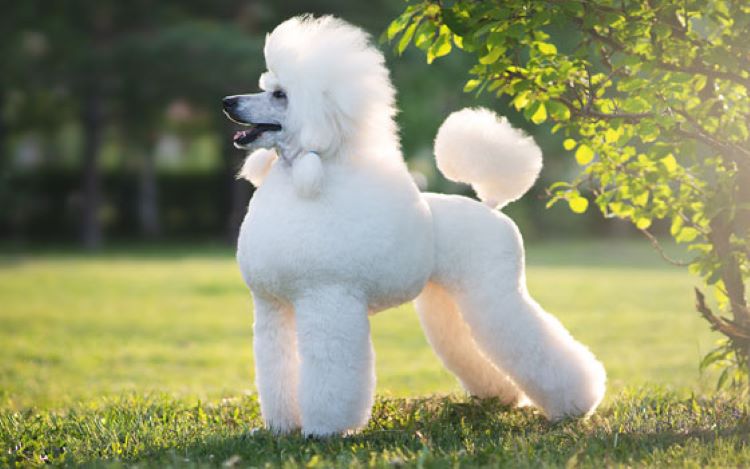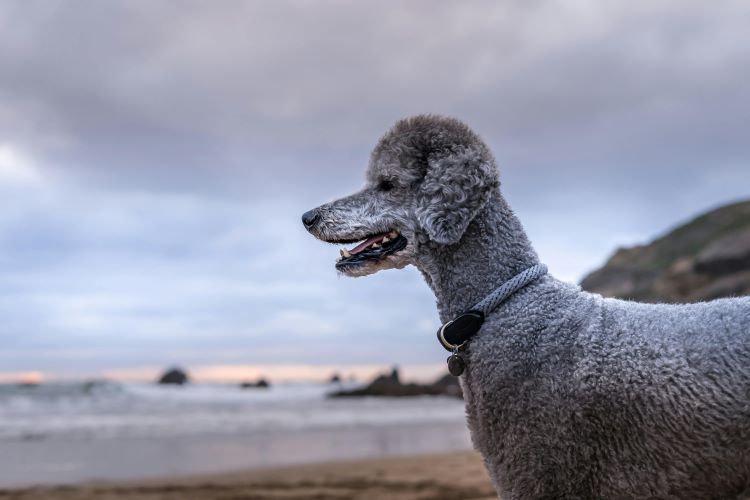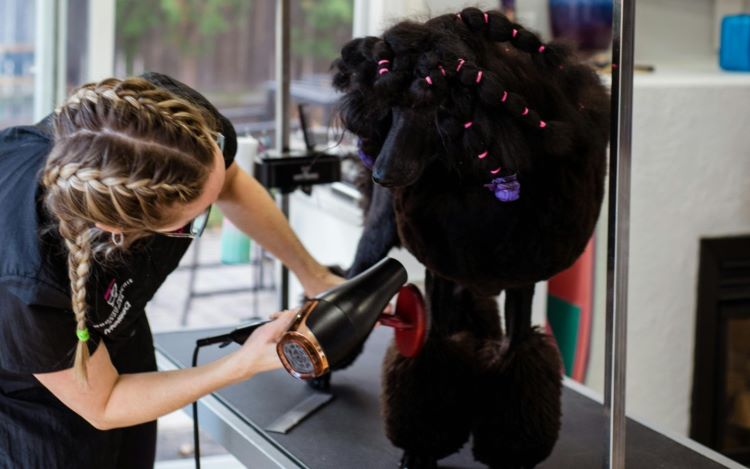Ready to help treat your pet to a healthy life?
Standard Poodle Breed Guide: Fun facts, Health & Care Tips
By : Trupanion Staff | Updated Apr 17, 2024

Standard Poodles are often recognized by their sophisticated and flamboyant haircuts. They also have long, elegant legs and a majestic appearance. But don’t let their fancy hairstyles fool you — Standard Poodles are sturdy, athletic, goofy, and playful dogs. Their intelligence means they love having a problem to solve, and they relish in learning new tricks they can show off to their fans. While sometimes a bit more reserved with strangers, Standard Poodles are very affectionate with people they know and tend to be extremely loyal to their family.
Debating whether or not to adopt one of these gorgeous dogs or simply wish to learn more about the breed? We've put together this Poodle guide to help!
10 fun facts about the Standard Poodle
- Standard Poodles can get pretty big! Full-grown members of the breed typically weigh between 40 and 70 pounds (18 to 32 kg), but there's also the "Royal Poodle" or "Giant Poodle" variant of the Standard that can grow up to 27 inches tall and weigh 100 pounds or more!
- Siba, a black Poodle rocking a luxurious hairdo, won Best in Show at Westminster in 2020.
- Poodles come in lots of different colors; most commonly black, white, and apricot. You might see them in blue, brown, red, gray, silver, cream, or silver beige. When a Poodle is two different colors, it’s called “particolored.”
- The breed is referred to as caniche in French, which means "duck dog."
- The Standard Poodle is technically the oldest of the three sizes of Poodle. The Miniature Poodle appeared on the European scene not long after the Standard became popular. The Toy Poodle was first bred in America during the early 1900s.
- A Poodle measuring more than 25 inches at the withers is often marketed as a ‘Royal’ Poodle. Royal as they might be, they are still considered a Standard Poodle by the American Kennel Club.
- The Standard Poodle is a natural entertainer! Their smarts and good looks made them a favorite of the French circus during the late 1800s.
- While their fancy haircuts might seem excessive, when Standard Poodles were used as water retrievers, the style was quite functional. By keeping their coat over the joints and vital organs, Poodles stayed warmer in water but could still swim without the drag and weight of a full coat.
- From 1988 through 1991, Alaskan musher John Suter had Poodles on his dogsled team for the Iditarod and related races. Unfortunately, many of these Poodles suffered in the harsh winter weather, eventually leading the Iditarod to limit competition to only northern dog breeds like Huskies and Malamutes.
- While poodles are considered “hypoallergenic” and often a better option for people who are allergic to dogs, there truly is no such thing as a non-shedding dog. People with allergies might still be sensitive to a Poodle’s dander.
History of the Standard Poodle
Poodles have been galivanting around Europe since at least the 15th century when depictions of recognizable Poodles can be seen in the artwork. Rembrandt even painted a self-portrait in 1631 with his Poodle sitting faithfully in front of him. These dogs were a favorite hunting dog of the wealthy, used as water retrievers when hunting wild fowl.
The larger Poodles, now known as Standard Poodles, were bred smaller throughout the 18th and 19th centuries to create the Miniature Poodle, which was popular with aristocrats and royalty as a companion dog. Their quick learning and eagerness to please made them a perfect choice for circus dogs in France during the late 1800s, and the country fell in love with the breed — the French eventually made the Poodle the official national dog breed.
The name Poodle is derived from the German word pudel, which means “to splash in water” — fitting for this water-loving breed. Their country of origin is most likely Germany, but some believe they could be a descendant of the Barbet, a French dog breed.
The Standard Poodle is one of the first official dog breeds recognized by all the different breed clubs around the world. The American Kennel Club recognized the breed in 1887.

Standard Poodle Behavior and Training
Standard Poodles are eager to please and incredibly smart, making them a favorite for trick training and dog sports. Using positive reinforcement training methods creates a strong bond and trusting relationship between a Poodle and their owner. Start training a Standard Poodle as a puppy to keep their minds engaged, build foundational skills and positive socialization experiences, and prevent bad habits from developing. This breed is ready and willing to solve problems and needs something to put their mind to, from puppyhood to their senior days.
Similar breeds
Numerous dog breeds have been crossed with Poodles over the years, largely in an attempt to create hypoallergenic dogs. While traits can (and do) vary significantly among these pups, they often have coats similar to the Poodle's as well as their energy and loyalty. While these crosses are generally not recognized by kennel clubs, some have nevertheless become socially recognized as breeds of their own:
- Miniature Poodle
- Toy Poodle
- Goldendoodle
- Labradoodle
- Maltipoo
- Cockapoo
Breed temperament
Standard Poodles might be a bit reserved when first meeting new people, but they generally warm up quickly and can be quite sociable. Proper proactive exposure to new sights, sounds, people, dogs, and other animals as a young puppy is essential for their socialization skills.
This larger size of Poodle is a popular choice for families. As long as they are socialized from puppyhood, and children are taught to be respectful in their interactions, Standard Poodles can make great family dogs. Young children and dogs should always be supervised, and it’s helpful for a dog to have their own “safe space” where they can go when they need some quiet time. Standard Poodles likewise tend to do well with other animals in the home, as long as they have been socialized and properly introduced.
Exercise requirements
Standard Poodles need a good amount of exercise and do best with at least 60 minutes of physical activity every day. Beyond just regular walks, add in some playtime in the backyard, or take advantage of a Poodle’s love of water and try swimming. Just be sure to thoroughly dry and brush out their coat to prevent matting and hot spots after getting wet. Be sure to clean and dry their ears to prevent ear infections as well. Once a Standard Poodle is fully grown, they make great jogging or hiking companions.
Speak with your veterinarian about appropriate exercise for a Poodle puppy. Until they are full-grown (bone growth plates typically all close by around 12 to 18 months of age), avoid excessive strenuous or repetitive activities like jogging or running, as this can possibly increase their risk of damage to the growing bone and cartilage and cause pain and future joint issues.
Mental enrichment needs
Providing your Standard Poodle with brain games and enrichment activities will go a long way in preventing boredom and unwanted behavior. This breed is incredibly smart and loves to solve problems. Feeding their meals from food puzzles and giving them interactive toys can also help burn any excess energy. Participating in different training classes, such as nose work or trick training, is a fun way to strengthen your relationship with your Standard Poodle and keep their brain sharp.
Activities for Standard Poodles
Standard Poodles do well in many different activities:
- Conformation
- Agility
- Trick Training
- Rally Obedience
- Dock diving
- Retrieving trials
- Canine Freestyle
- Therapy Work
- Service dog training
- Nosework / Tracking
Standard Poodle grooming and care
Standard Poodles have a curly single-layer coat that sheds very little due to its hair-like quality. Because this breed doesn’t have the insulating undercoat like double-coated breeds, they can be sensitive to the cold. They’ll appreciate having a warm fleece or jacket when outside in chilly weather, especially if their fur is clipped short.
Those famous fancy show cuts serve a functional purpose. When used as water retrievers, Poodles need to keep their joints warm but not be weighed down by a full coat while swimming.
Rather than falling out after growing to a certain length, Poodle coats will just keep growing. This makes their coat prone to tangling and matting. A Standard Poodle requires a thorough combing every day to prevent knots and tangles, especially after getting wet. Professional grooming is typically required to manage coat length and address any matting. Many Standard Poodle owners keep their dog’s coat cut short to make maintenance easier or learn how to clip the coat themselves.
Set yourself and your Poodle up for success by introducing them to the brushing and grooming process as a puppy and in a positive way, with regularly-scheduled professional grooming at least every 4 to 8 weeks (or more frequently if you prefer a shorter coat length).
A Standard Poodle puppy as young as 12 weeks can be introduced to professional grooming, whether at a grooming salon or scheduling a mobile groomer to come to your home. You’ll want to make sure the facility is clean, your puppy is kept separate from other dogs, and they are up to date on vaccinations and parasite preventatives (be sure to check with your vet first). Breeders can introduce their puppies to different grooming tools (such as brushes, nail trimmers, and clippers) and handle them in a positive way as young as five weeks old. Owners can continue this proactive exposure training when they bring the puppy home.
Best Brush for a Standard Poodle: Pin comb, Slicker brush

Common Medical Conditions
Common health conditions for the Standard Poodle include (but may not be limited to) the following:
- Epilepsy
- Hip dysplasia
- Progressive retinal atrophy, a degenerative eye disease that can result in blindness (especially if left untreated)
- Addison's disease, a hormonal imbalance that affects the adrenal glands
- Von Willebrand's disease, a disorder where the blood does not clot correctly
You can't predict your Poodle's health, but you can take steps to protect against veterinary emergencies. Keep up with regular veterinary visits, and get a good dog insurance policy (preferably while your pup is still young). These measures will help lessen the worry and stress that comes with dog health conditions, and you may even be able to catch issues early before they progress to more serious situations.
Standard Poodles in pop culture
With its memorable looks and intelligence, the Standard Poodle is a natural when it comes to acting gigs and other media appearances. This breed has also been associated with numerous famous figures over the years.
Famous Owners of the Poodle
- Stevie Nicks (Singer)
- Jaclyn Smith (Actress)
- Prince Ruper of the Rhine (Royalty)
- Charles Dickens (Author)
- Robin Williams (Actor)
- Cary Grant (Actor)
- Jack Lemmon (Actor)
- Katharine Hepburn (Actress)
- Barbara Streisand (Singer/Actress)
- John Steinbeck (Author)
Standard Poodles in Books, Movies and TV
- One of the neighborhood dogs from Edward Scissorhands
- Butch or "Rhapsody in White" from Best in Show
- The dogs Alfred Hitchcock is walking during his cameo in The Birds
